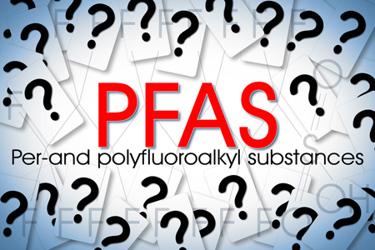Complete PFAS Removal: Are Current Proposals Enough?

By Kevin Westerling,
@KevinOnWater

An expert shares his viewpoints on per- and polyfluorinated substances (PFAS), including the direction of regulations as well as what can and should be done to root out the contaminants for good.
John Brockgreitens is Vice President of Research & Development for Claros Technologies, an advanced materials company that designs and develops sustainable materials and solutions for a circular economy. He holds a PhD in Biosystems Engineering from the University of Minnesota, and his expertise includes the development and application of nanomaterials in environmental systems. As such, and due to his role overseeing product development and research activities at Claros — which offers a solution to the pervasive (and soon to be regulated) PFAS problem — he offers excellent insights on mitigation. Here’s his take on some key areas of consideration around this hot topic.
What is the latest on PFAS rulemaking, and are the proposed mandates enough to protect the public?

We fully support all efforts to clean up PFAS pollution, yet we believe regulations could be clearer, stronger, and more comprehensive. The current proposed national standard would regulate only six of the thousands of PFAS that have been created since the 1950s when they began to be commonly used in consumer and industrial products.
Another consideration is that efforts to destroy PFAS compounds such as incineration often degrade but don’t destroy them, leading instead to short-chain or ultra-short-chain PFAS. The fact that PFAS can chemically react and be broken down but not completely destroyed makes them elusive “shapeshifters” that seem to defy destruction.
One possible solution is to approach PFAS as a class, focusing on their commonality instead of their differences. One thing all PFAS have in common is the powerful carbon-fluorine bond that is the strongest in organic chemistry. This approach would help ease the seemingly never-ending whack-a-mole approach to regulating compound by compound.
This class-based approach is not without its challenges. First, there is no agreement on the definition of PFAS among major actors including the U.S. EPA, the U.S. Department of Defense, and the European Union. Second, many consumer goods and pharmaceuticals that contain PFAS do not currently have any reliable alternatives to the “forever chemicals.”
However, we believe that solving the problems of a class-based approach is more expedient and better for the environment in the long run. We also believe that is important to establish enforceable limits for PFAS in air, biosolids, and soil, as well as water.
What are the alternative options to existing PFAS chemicals to counter more pollution? Do these alternatives present their own issues?
Finding alternatives to products that use PFAS is a critical part of the solution. PFAS are commonly used in the textile industry. That’s why Claros Technologies has developed eco-friendly products and processes to help the industry manufacture technical textiles without the use of PFAS. For example, ZioRay, is an OEKO-TEX-certified product that infuses textiles with ultraviolet protection factor (UPF) without the use of harmful ingredients. Equally important, the UPF property is very durable and does not wash out. Claros also has developed environmentally safe processes that provide durable antimicrobial, moisture-wicking, and odor-resistant properties.
However, finding alternatives to PFAS isn’t always so easy. Take, for example, straws. Paper straws are increasingly replacing plastic straws in an effort to eliminate single-use plastics. Yet plant-based straws use PFAS for its water-repellent nature. So, are microplastics or PFAS worse for the environment? There are a multitude of these tradeoffs that need to be weighed.
What are the most effective strategies for starting PFAS cleanup and destruction?
We recommend a three-step approach for PFAS management in wastewater: analysis, capture and concentration, and destruction. First, the Claros Analytical Lab uses compound-specific tests and class-based tests such as total organic fluorine (TOF).
Second, we employ capture and concentration methods that work well alone or in conjunction with existing filtration systems such as ion resin, reverse osmosis, and foam fractionation. This critical step filters millions of gallons of wastewater into a few gallons of PFAS concentrate.
Third, we use a photochemical that destroys long-chain, short-chain, and ultra-short-chain compounds in a way that is wholly traceable. Our process has a small physical footprint and a small greenhouse gas footprint, because defluorination is conducted at ambient temperatures and pressure.
Where are the technology or training gaps when it comes to PFAS treatment? Are drinking water utilities properly equipped for the upcoming regulations?
Truthfully, no one is equipped for the upcoming regulations. PFAS management is still a very nascent industry trying to operate in an environment with different and ever-changing rules, regulations, and needs by industry, by state, by country, and by region. The EPA is following its PFAS Strategic Roadmap but there are a number of states that already regulate or have proposed regulations.
The first issue is determining the regulatory landscape. The second issue is finding partners with technology and expertise that are proven and trusted. There aren’t currently any certifications for PFAS management, though we would welcome these. However, the EPA’s Small Business Innovation Research (SBIR) program has seeded a number of companies that test and treat PFAS.
Testing will be necessary for drinking water utilities as part of the new mandate(s), but who else and where else should we be testing to ensure public protection from PFAS?
Ideally, PFAS testing and management should be conducted upstream as well as downstream. The EPA has given some guidance, identifying the following five categories in its multi-industry PFAS study: organic chemicals, plastics, and synthetic fibers (OCPSF); metal finishing; pulp, paper, and paperboard; textile mills, and commercial airports.
I would argue that testing should also be conducted for soils that are used for agriculture and grazing lands to try to keep PFAS out of the food chain.
Are there other emerging contaminants that we should be on the lookout for?
Unfortunately, there are always emerging contaminants. I can’t really speculate on what those are or will be. The scale and scope of the PFAS pollution problem is keeping me plenty busy.
